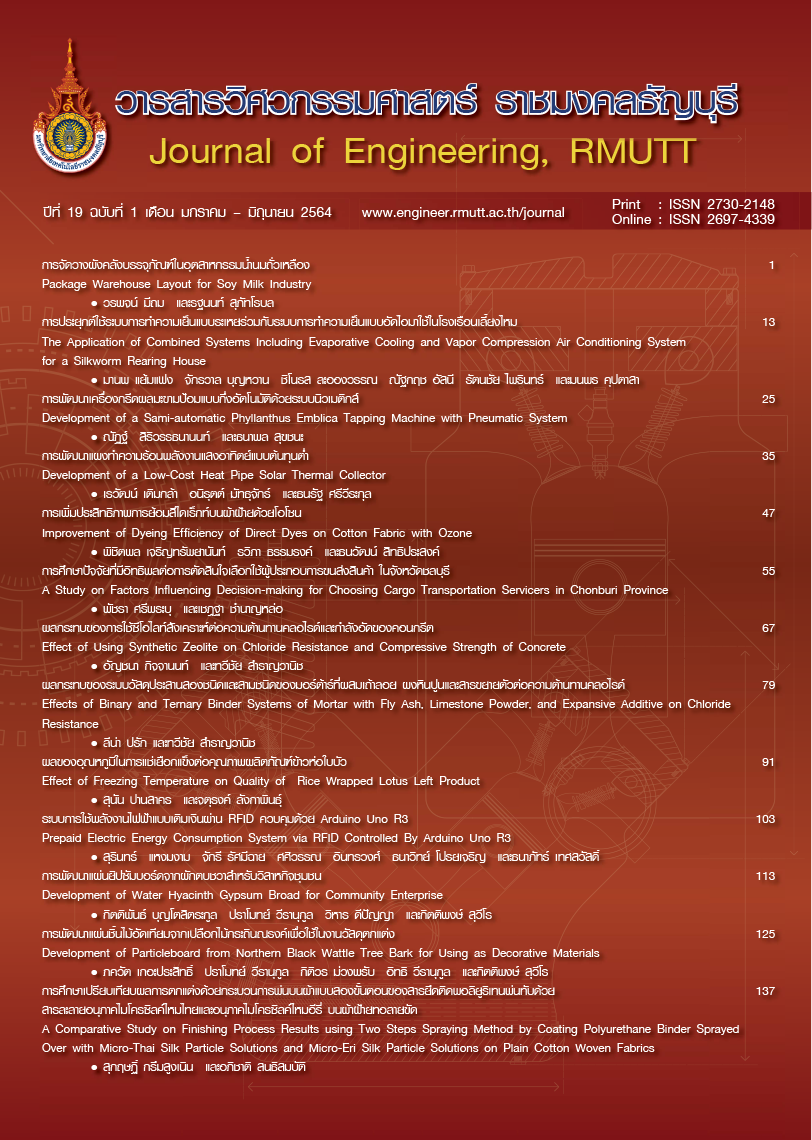การพัฒนาแผงทำความร้อนพลังงานแสงอาทิตย์แบบต้นทุนต่ำ
##plugins.themes.bootstrap3.article.main##
摘要
งานวิจัยนี้นำเสนอการพัฒนาแผงทำความร้อนพลังงานแสงอาทิตย์แบบต้นทุนต่ำ โดยออกแบบแผงทำความร้อนแบบแผ่นเรียบ ขนาดพื้นที่ 1.5 ตารางเมตร ใช้ท่อความร้อนทองแดง (Heat Pipe) จำนวน 12 ท่อ ในการแลกเปลี่ยนความร้อนกับน้ำในท่อรวมน้ำ (Manifold) ทดสอบสมรรถนะเชิงความร้อนตามมาตรฐาน ASHRAE Standard 93-77 โดยมีเงื่อนไข คือ การเปลี่ยนอัตราการไหลของน้ำเข้าแผง 3 ระดับ ได้แก่ อัตราการไหล 40 60 และ 80 ลิตรต่อชั่วโมง พบว่า อุณหภูมิของน้ำที่ออกจากแผงและประสิทธิภาพของแผงขึ้นอยู่กับความเข้มของรังสีอาทิตย์และอัตราการไหลของน้ำ โดยอุณภูมิของน้ำสูงสุดที่แผงผลิตได้เท่ากับ 53 องศาเซลเซียส ที่อัตราการไหล 40 ลิตรต่อชั่วโมง ความเข้มรังสีอาทิตย์เฉลี่ยรวม 6 ชั่วโมงต่อวัน เท่ากับ 3.95 กิโลวัตต์ต่อตารางเมตร และที่อัตราการไหล 80 ลิตรต่อชั่วโมง ความเข้มรังสีอาทิตย์เฉลี่ยรวมต่อวัน 3.39 กิโลวัตต์ต่อตารางเมตร แผงทำความร้อนพลังงานแสงอาทิตย์มีค่าประสิทธิภาพเชิงความร้อนสูงสุด 55.61 เปอร์เซ็นต์ โดยค่าการสูญเสียพลังงานความร้อนของแผง ที่อัตราการไหล 40 ลิตรต่อชั่วโมง มีค่ามากที่สุดเท่ากับ 3.40 วัตต์ต่อตารางเมตร รองลงมาคือที่อัตราการไหล 60 และ 80 ลิตรต่อชั่วโมง มีค่าเท่ากับ 2.60 วัตต์ต่อตารางเมตร และ 1.63 วัตต์ต่อตารางเมตร ตามลำดับ การวิเคราะห์ทางเศรษฐศาสตร์พบว่าแผงเก็บรังสีอาทิตย์แบบต้นทุนต่ำมีระยะเวลาคืนทุน 1.35 ปี ในขณะที่แผงเก็บรังสีอาทิตย์แบบแผ่นเรียบและแบบสุญญากาศที่ขายตามท้องตลาดมีระยะเวลาคืนทุนที่ 2.25 ปี และ 1.54 ปี ตามลำดับ
##plugins.themes.bootstrap3.article.details##
The manuscript, information, content, picture and so forth which were published on Frontiers in engineering innovation research has been a copyright of this journal only. There is not allow anyone or any organize to duplicate all content or some document for unethical publication.
参考
Promnamchum S, Nuanplub K, Plangklang B, Biansoongnern S. Measurement and display system for solar radiation. Journal of Engineering RMUTT.2007;10(2):87-92. (in Thai)
Department of Alternative Energy Development and Efficiency. Solar water heater (Hybrid Solar water heater system) Ministry of Energy. [Internet]. 2013 [cited 2020 Jan 25]. Availablefrom:http://www.tsus.co.th/ download /d4.pdf. (in Thai)
O’Hegarty R, Kinnane O, McCormack S. Parametric analysis of concrete solar collectors. International Conference on Solar Heating and Cooling for Buildings and Industry. Energy Procedia. 2016;91:954-62.
Sukchai S, Suriwong T, Chamsa-ard W, Sonsaree S, Laodee P. The development of flat plate solar collector integrated with compound parabolic concentrator (CPC). [Research]. School of Renewable Energy Technology: Naresuan University; 2013. (in Thai)
Sirisamphanwong C, Ngoenmeesri R, Ketjoy N, Chamsa-ard W. Determination of annual energy yield of solar conllector. Naresuan University Journal: Science and Technology (NUJST). 2013;20(1):16-23. (in Thai)
Nshimyumuremyi E, Junqi W. Thermal efficiency and cost analysis of solar water heater made in Rwanda. Energy Exploration & Exploitation 2019;37(3):1147–61
Struckmann F. Analysis of a flat-plate solar collector. Project Report 2008-MVK160. Heat and Mass Transport. [Internet]. Lund, Sweden. [cited 2020 May 25]. Available from: http:// www.lth.se/fileadmin/ht/ Kurser/MVK160/Project_08/Fabio.pdf
Department of Alternative Energy Development and Efficiency. Project to promote the use of hot water from solar energy with an integrated system, 3rd. Ministry of Energy. [Internet]. 2012. [cited 2020 Jan 15]. Available from: http://webkc.dede.go.th/ testmax/sites/default/files. (in Thai)
Ashrea Standard 93-77. Methods of Testing to Determine the Thermal Performance of Solar Collectors. New York: The America Society of Heating Refrigerating and Air Conditioning Engineers. 1978.

